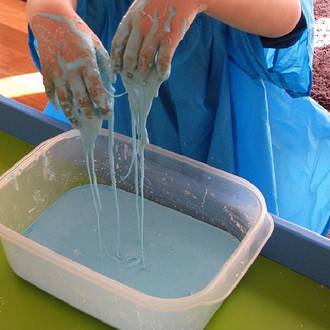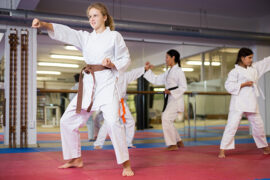Ultimate Guide to Making Cornflour Goo: A Fun and Educational Recipe for Kids
Ready for some squishy, ooblecky, magical fun? Roll up your sleeves, because it’s time to dive into the world of cornflour goo—a delight for both young and old alike!
The Magic of Cornflour Goo
Oh, the wonders of cornflour goo! Not only does it provide hours of entertainment, but it’s also a lightweight champion of sensory play—an excellent way for your kids to explore textures, practice motor skills, and nurture creative thinking. It’s a snap to make, and I promise, once your little ones get their hands on this gooey goodness, they’ll be occupied (and educated!) for a long time.
Why Cornflour Goo is a Parent’s Best Friend
First things first, let’s talk about safety. Cornflour goo is non-toxic, which means it’s a big yes for worried parents. It’s also gluten-free, making it a safe choice even if your child has gluten sensitivities. Plus, cleaning up is as easy as pie (we’ll get to that later), so you can relax and watch the fun unfold without fretting over the aftermath.
What You’ll Need
Gathering supplies is as easy as one-two-three! Here’s a quick list:
- Cornflour (cornstarch): This is the star of our show, readily available in your pantry or just a quick dash to the grocery store.
- Water: Plain ol’ tap water will do the trick here—no need for anything fancy.
- Food coloring: This is optional, but if you want to add a pop of color to your goo, go for it! Make sure to use a food-safe variety.
- Bowls and spoons: For mixing and experimenting with your gooey creation.
- Measuring cups: To make sure we have just the right amounts.
Simple Steps to Gooey Glory
Now, onto the magic potion itself! Follow these simple steps, and you’ll have your very own homemade goo in no time:
- Measure out your cornflour (we recommend starting with 1 cup for a decent sized batch).
- Gradually add in water (start with half a cup) and mix until you achieve a gloopy consistency.
- If you’re using food coloring, now’s the time to add a few drops and stir it into the mix—you’ll see vibrant colors come to life!
- Once you’ve reached the perfect consistency—not too solid, not too liquid—invite your child to get their hands in and explore.
Do remember, the consistency is key here; you want to be able to run your fingers through the goo, but also let it solidify when you squeeze it. It’s all part of the non-Newtonian fluid fun!

Five Essential Tips for Preparing Cornflour Goo
While making cornflour goo is simple and straightforward, a few insider tips can elevate your goo-making experience. Pay attention, parents, because here are five things you should know:
1. Ratio Matters: Getting the Perfect Texture
Starting with the basic 1:0.5 ratio of cornflour to water is great, but sometimes you need to adjust. Too runny? Add a bit more cornflour. Too thick? A splash more water will do. Trust your touch and let the texture tell you when it’s just right.
2. Color with Care: Keep Messes at Bay
When you add food coloring, less is often more—you can always add extra drops, but you can’t take them away. Mix it in a separate container before adding to your goo to avoid staining those tiny hands.
3. Patience is Key: Give it Time to Settle
Once you’ve mixed everything up, let it sit for a minute or two. You’ll notice the goo’s texture becomes even more fascinating as it settles into its unique state of semi-solid awesomeness.
4. Embrace the Mess: Prep Your Play Area
Things might get messy, and that’s okay! Set up on a surface that’s easy to clean, or consider play trays and mats. Covering the table with parchment paper or using a wipeable cloth under the bowls can be a real game-changer for cleanup.
5. Allergy Alert: Double-Check Ingredients
Although cornflour is gluten-free, if your child has specific allergies, always check the packaging to ensure there’s no cross-contamination or additional ingredients that might pose a risk.
Engaging Activities with Cornflour Goo
Our ploppy friend isn’t just for poking and prodding! Here’s how you can use cornflour goo for some engaging activities:
- Science Experiments: Teach your kids about non-Newtonian fluids and have them guess if the goo is a solid or a liquid. Put it to the test by punching it (gently!) and watching it harden, then letting it slink through your fingers when released.
- Creative Play: Cornflour goo can be an art medium too! Let kids use their fingers to draw patterns on a surface coated with goo or on parchment paper. Add in some glitter or small waterproof toys for an extra element of fun.
- Themed Play: Match your goo to the season or an upcoming holiday. Pumpkin orange for fall, icy blue for winter, or vibrant hues for spring—tailor your cornflour goo with colors that fit the theme!
Soothing Sensory Play
Did you know? Cornflour goo can also be calming. Its unique texture makes it a great tool for sensory play, helping children (and even adults) relax. Slowly run your fingers through it and feel the stress ooze away.
Storing Your Cornflour Goo
Don’t say goodbye too soon! If stored properly in an airtight container, your goo can last several days. Remember to check for signs of dryness or mold before each play session, though. If it’s dried out, adding a touch of water can revive it.
Cleanup Can Be Fun Too!
Inevitably, what goes up must come down, and what gets played with must be cleaned up. But fear not! Let the goo dry a bit and it’ll come right off most surfaces. Do try to keep it away from fabrics and drains. For maximum safety, discard used goo in the trash, not the sink.
FAQs for Cornflour Goo Aficionados
Got questions? We’ve got answers! Head on over to our FAQ section where we tackle all your cornflour goo curiosities—from making it last longer to troubleshooting common goo-blems. We’ve got you fully covered!
See more great Things to Do with Kids in New Zealand here. For more information see here
Disclaimer
The articles available via our website provide general information only and we strongly urge readers to exercise caution and conduct their own thorough research and fact-checking. The information presented should not be taken as absolute truth, and, to the maximum extent permitted by law, we will not be held liable for any inaccuracies or errors in the content. It is essential for individuals to independently verify and validate the information before making any decisions or taking any actions based on the articles.




